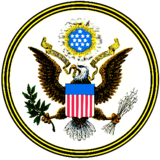Chief Justice of the United States
|
|
The Chief Justice of the United States is the head of the Judicial Branch of the government of the United States, and presides over the Supreme Court of the United States.
The office is often but incorrectly referred to as "Chief Justice of the Supreme Court." The United States Code specifies the title as "Chief Justice of the United States," and thus, not just of the Court itself. The title changed at the suggestion of Chief Justice Salmon P. Chase, who wished to emphasize the Court's role as a coequal branch of government.
The Supreme Court is composed of nine members, though that number has varied over the years, headed by the Chief Justice. The Chief Justice, like all the other justices, is nominated by the President and confirmed to sit on the court by the U.S. Senate. Some justices, like William H. Rehnquist, were elevated to the highest post on the court by the President after having served previously on the bench as Associate Justice. Most others, like William Howard Taft (a former President himself) and Earl Warren, were nominated to the highest bench without any previous experience on the court.
Duties
In addition to the duties of the Associate Justices, the Chief Justice has the following duties:
- If the Chief Justice is in the majority on a Supreme Court case, he or she may decide to write the Opinion of the Court, or may assign it to an associate justice of his or her choice.
- Presides when the Senate tries impeachments of the President of the United States
- Two Chief Justices, Salmon P. Chase and William Rehnquist, have had the duty of presiding over Presidential impeachments and trials--Chase in 1868 over the proceedings of President Andrew Johnson and Rehnquist in 1999 over the proceeding against Bill Clinton.
- Presides over the impeachment trial of the Vice President if the Vice President is serving as Acting President (not a Constitutional responsibility but a rule of the Senate).
- Traditionally officiates at the inauguration of the President of the United States. (This is not a Constitutional responsibility, however. All federal judges are empowered by law to administer oaths and affirmations, and the Chief Justice administers this oath due to the pomp and circumstance. The incoming President technically could choose any judge or any other officer with notarial powers. This often happens when a President dies in office and the Chief Justice cannot be summoned for the emergency inauguration.)
- Serves as the Chancellor of the Smithsonian Institute (also not a Constitutional responsibility).
- Serves as the head of the Judicial Conference of the United States, the chief administrative body of the U.S. federal courts. The Judicial Conference is empowered by the Rules Enabling Act to promulgate rules to ensure the smooth operation of the federal courts. It has created rules covering civil procedure and evidence which have been adopted in many states for their courts, and thus those rules have become the backbone of courses on those topics in law schools across the United States.
List of Chief Justices
- * Denotes interim Chief Justice
- ** Denotes elevation from Associate Justice

